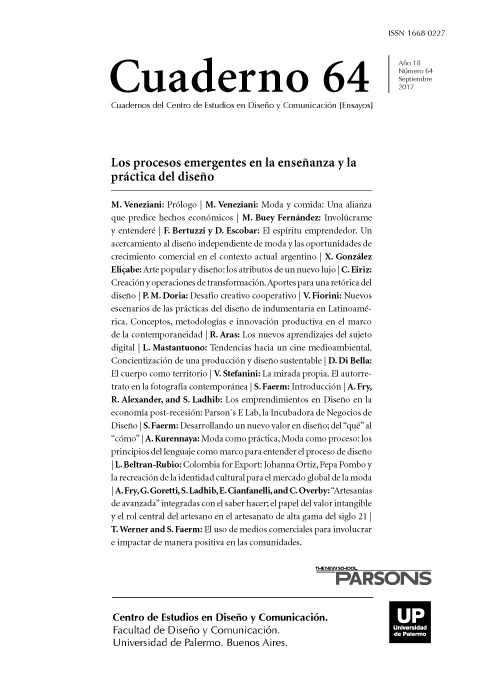The utilization of commercial media to engage and positively impact communities
Resumen
Históricamente, las empresas se han dirigido a grupos de consumidores homogéneos a través de los diferentes medios de comunicación social. Sin embargo, debido a los cambios radicales de los mercados y de los consumidores, las empresas están desarrollando narrativas visuales heterogéneas que atraviesan de manera fluida las fronteras culturales, involucran a los crecientes grupos de consumidores socialmente comprometidos, y producen un impacto positivo en las comunidades. Estas narraciones se difunden al público de diversas culturas para promover el cambio social a nivel local, nacional y / o internacional. En este trabajo, los autores examinan las imágenes comerciales que crean narrativas visuales y escritas de peso para generar cambios sociales y culturales. Se presentan las campa- ñas desarrolladas por grandes empresas como Levis, Nike, Apple y Dove, para una mejor comprensión de los contextos culturales, entornos de consumo local / global, y el impacto social. Luego, los autores consideran la función de estos conceptos como herramientas que los estudiantes pueden utilizar para crear narrativas visuales exitosas, y como ejemplos de los desafíos que pueden existir en un entorno académico culturalmente diverso. Una única configuración áulica se contextualiza a través de cuatro presentaciones sobre el tema, cada uno en un entorno culturalmente diverso: la Escuela de Verano de The United Nations Education First (UN/EF); el Museo Estatal del Hermitage en San Petersburgo, Rusia; la Galería Estatal de Kaliningrado, Rusia; y Parsons School of Design, New York. Las distintas perspectivas de los estudiantes permite entender cómo se percibe la función del lenguaje visual y cultural en un contexto comercial y educativo a nivel local, nacional e internacional.
Citas
Armstrong, A. (2015, October 24). Benetton leaves shock tactics behind as it seeks to stay in fashion. The Telegraph. Retrieved from http://www.telegraph.co.uk/finance/newsbysector/retailandconsumer/11952130/Benetton-leaves-shock-tactics-behind-as-it-seeks-to-stayin-fashion.html
Attwell, J. (2013, February 14). Alessandro Benetton on building a brand out of controversy. Marketing Magazine Online. Retrieved from http://www.marketingmagazine.co.uk/article/1170425/alessandro-benetton-building-brand-controversy
Avi, D. (2013, April 21). Dove’s new video is a beauty, but is it a bit skin deep? Forbes. Retrieved from http://www.forbes.com/sites/avidan/2013/04/21/doves-new-video-is-abeauty-but-is-it-a-bit-skin-deep/#417f1db248c5
Butt, R. (2011, November 17). Benetton tears down pope-kissing ads after Vatican legal threat. The Guardian. Retrieved from http://www.theguardian.com/world/2011/nov/17/benetton-pope-kissing-ads
Celebre, A. & Denton, A. (2014, February). The good, the bad, and the ugly of the Dove campaign for real beauty. The Inquisitive Mind Magazine. Retrieved from http://www.inmind.org/article/the-good-the-bad-and-the-ugly-of-the-dove-campaign-for-real-beauty
Delzio, S. (2015, June 9). 12 social media marketing trends for small business. Social Media Examiner. Retrieved from http://www.socialmediaexaminer.com/social-media-marketingtrends-for-small-business/
Dove, Inc. (2016 [2011]). Our research. Retrieved from http://www.dove.us/Our-Mission/Girls-Self-Esteem/Our-Research/default.aspx
Elliott, S. (2010, June 23). Levi’s features a town trying to recover. The New York Times. Retrieved from http://www.nytimes.com/2010/06/24/business/media/24adco.html.
Evans, M. (2013, March 20). The importance of really knowing your target audience. Forbes. Retrieve from http://www.forbes.com/sites/markevans/2013/03/20/the-importance-ofreally-knowing-your-target-audiences/#415f04966ddc
Gianatasio, D. (2013, July 2). Happy 25th birthday to Nike’s ‘Just Do It,’ the last great advertising slogan. Advertising Week. Retrieved from http://www.adweek.com/adfreak/happy-25th-birthday-nikes-just-do-it-last-great-advertising-slogan-150947
Grose, J. (2013, April 19). The story behind Dove’s mega viral “Real Beauty Sketches” campaign. Co.Create. Retrieved from http://www.fastcocreate.com/1682823/the-storybehind-doves-mega-viral-real-beauty-sketches-campaign
Hogquist, R. (2010). Epica book 23: Europe’s best advertising. London: Thames & Hudson, Ltd.
Karimzadeh, M. (2013, January 27). Kenneth Cole marks 30 years with ad campaigns. Women’s Wear Daily. Retrieved from http://wwd.com/globe-news/advertising/kennethcole-marks-30-years-6663843/
Kenneth Cole Productions, Inc. (2008). We all walk in different shoes: 25 Years of nonuniform thinking. PR Newswire. Retrieved from http://www.prnewswire.com/newsreleases/we-all-walk-in-different-shoes-56807927.html
Levi Strauss & Co. (2015). We are all workers: 2010 Levis Strauss & Co. commercial [Television Commercial]. Retrieved from http://adsoftheworld.com/media/tv/levis_to_work
Mezzofiore, G. (2011, November 18). Benetton: A history of shocking ad campaigns. International Business Times. Retrieved from http://www.ibtimes.co.uk/benetton-historyshocking-ad-campaigns-pictures-252087
Neff, J. (n.d.). What the judges had to say about Dove’s ‘campaign for real beauty.’ Advertising Age. Retrieved from http://adage.com/lp/top15/#realbeauty
Russell, M. (2014, June 9). How Dove’s campaign for real beauty ushered in new age of female empowerment. Visible Measures. Retrieved from http://www.visiblemeasures.com/2014/07/09/how-doves-campaign-for-real-beauty-ushered-in-new-age-of-femaleempowerment/
Stampler, L. (2013, May 22). How Dove’s ‘Real Beauty Sketches’ became the most viral video ad of all time. Business Insider. Retrieved from http://www.businessinsider.com/how-doves-real-beauty-sketches-became-the-most-viral-ad-video-of-all-time-2013-5
Statista. (2015a). Share of internet users in the United States as of May 2015, by age group. Retrieved from http://www.statista.com/statistics/266587/percentage-of-internet-usersby-age-groups-in-the-us/
Statista. (2015b). Number of internet users in selected countries as of May 2015 (in millions). Retrieved from http://www.statista.com/statistics/271411/number-of-internet-users-inselected-countries/
Stevens, M. (1992, December 11) Change the world, buy a sweater. Chicago Tribune. Retrieve from http://www.chicagoreader.com/chicago/change-the-world-buy-a-sweater/Content?oid=880996
U.S. News Report (n.d.) Most international students: National universities. Retrieved from http://colleges.usnews.rankingsandreviews.com/best-colleges/rankings/nationaluniversities/most-international
United Nations Alliance of Civilizations - Education First (UNAOC-EF). (n.d.). Overview. Retrieved from http://www.unaocefsummerschool.org/
Wappling, D. (2013). Pink Ribbon Magazine launched - poetry for our girls (Boobies!). Adland. Retrieved from https://adland.tv/ooh/pink-ribbon-magazine-launched-poetryour-girls-boobies.
Wedel, M. & Kamakura, W.A. (2002). Introduction to the special issue on market segmentation. International Journal of Research in Marketing, 19, 181–183.
Wekesa, A. S. & Tsuma, F. C. (2014). Ethnic Media and Rural Development in Kenya. International Journal of Humanities and Social Science, 2(1), 246-253.
Williams, E. (2009, June 30). Levi’s Go Forth. Creative Review. Retrieved from https://www.creativereview.co.uk/cr-blog/2009/june/levis-go-forth/
Whitman, W., Cowley, M., & Charles E. Feinberg Collection of Walt Whitman (Library of Congress). (1959). Walt Whitman’s Leaves of grass: The first (1855) edition. New York: Viking Press.
Young, K. (2013, April 22). Dove’s new beauty campaign confirms that we are more beautiful than we think. The Telegraph. Retrieved from http://fashion.telegraph.co.uk/beauty/news-features/TMG10009657/Doves-new-beauty-campaign-confirms-that-weare-more-beautiful-than-we-think.html
Los autores/as que publiquen en esta revista ceden los derechos de autor y de publicación a "Cuadernos del Centro de Estudios de Diseño y Comunicación", Aceptando el registro de su trabajo bajo una licencia de atribución de Creative Commons, que permite a terceros utilizar lo publicado siempre que de el crédito pertinente a los autores y a esta revista.


